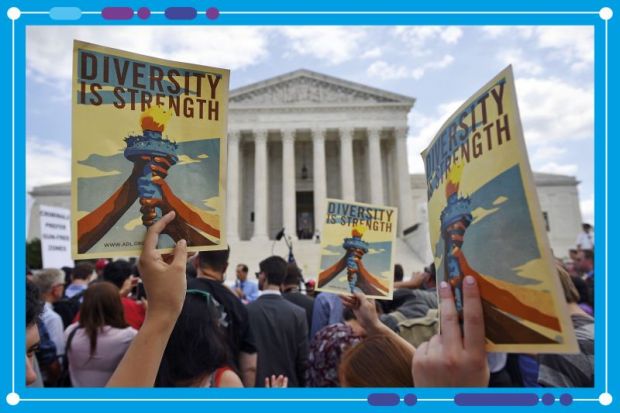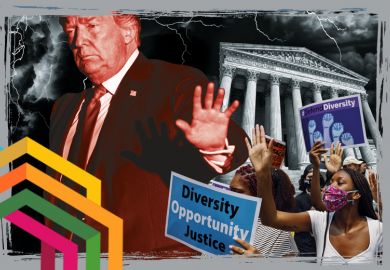Browse the full results of the World University Rankings 2025
Unconscious bias training gets a bad rap in the mainstream, right-leaning press, but what if it also doesn’t work? Harvard University scholar Frank Dobbin made a splash in the business world using large datasets to identify which diversity initiatives in US corporations precede an increase in the number of women and ethnic minorities in management roles. Now he’s turned his attention to university faculty.
According to the data, “all groups are more likely than white men to leave academia, pretty much every year, from the year they start on an academic track”, says Dobbin, Henry Ford II professor of the social sciences.
Meanwhile, a separate study of the UK’s Russell Group universities shows that it takes women almost 15 years longer than men to become professors. Women and individuals with ethnic minority backgrounds are much less likely to be employed in academia than white men, and the higher up the hierarchy, the less they are represented. While data on sex and ethnicity are more readily available, similar trends are seen with other groups, such as those with disabilities and people from working-class backgrounds.
It is a pattern that plays out across the world, despite universities putting considerable resource and effort into improvement. Experts generally agree that while universities in many regions have made strides in diversifying their student bodies, when it comes to faculty and staff, progress has been slower. So what’s going wrong?
According to Dobbin, university leaders, in the US at least, have tended to heed consultants rather than the academic literature on diversity.
In the 1990s, universities started doing corporate-style diversity programmes, he says. “The irony there is academics had already produced quite a lot of evidence by that point that diversity training would not change people’s minds or behaviours very much. So we kind of knew that that wasn’t a very promising path to go down. But nonetheless, presidents of universities listened to consultants, rather than reading the research from their own faculty and figuring out we shouldn’t be doing that.”
Dobbin’s research uses data on workforce demographic composition from 670 large colleges or universities in the US, going back to the early 1990s. Against this, he’s mapped which diversity initiatives they implemented and when, to see if they correlate with an improvement in the diversity of faculty in the subsequent years. The data hasn’t been published yet, but he told Times Higher Education that it follows a similar trend to the corporate world; several of the initiatives that universities implement actually lead to a decrease in faculty diversity.
Unconscious, or anti-bias, training is one of these. “One problem with anti-bias training, and harassment training generally, is that it’s accusatory. People feel they’ve been accused of doing something that they don’t think they did,” Dobbin says. Similarly, grievance systems – those that allow staff to report concerns and complaints – correlate with a reduction in faculty diversity yet continue to be used (“dispute resolution or ombudsperson systems work much better,” Dobbin says).
It is not just US universities that use initiatives that aren’t working. Nelarine Cornelius, professor of organisation studies at Queen Mary University of London and vice-president of membership and professional development at the Chartered Institute of Personnel and Development, says UK universities also use programmes that, the data suggest, do not work.
Unconscious bias training is common, yet “I don’t know why anybody in the UK would do it, because the Equality and Human Rights Commission did a piece of work that found there was no effect from unconscious bias training, except for a small effect when it’s done with leaders,” she says.
For Cornelius, the problem is that the responsibility for improving diversity tends to lie with human resources departments: “They are the ones that will determine, on average, what resources are spent on EDI training and how.”
She agrees with Dobbin that they should be looking to the academic literature on equality and diversity. But ascertaining which initiatives do actually boost diversity in the workforce involves using data, and may require the skills of specialist data analysts, she adds.
Several factors hinder the diversification of university faculty and staff, according to Edna Chun, a lecturer in the School of Professional Studies at Columbia University, who has written several books on diversity within US higher education. The decentralised nature of institutions makes it hard to implement diversity strategies, while the shift to universities being run more like businesses and, in the US, the drop in the proportion of tenured faculty means that academics have less power to push for change.
The latest barrier in the US is, of course, the politicisation of DEI (diversity, equity and inclusion, known as EDI in the UK) and the new laws in many states that ban public universities from spending money on diversity initiatives. “People in the states that have banned DEI are afraid to talk about it,” Chun says.
Madeleine Wyatt, associate dean for equality, diversity and inclusion at King’s College London’s business school, has studied the diversity make-up of universities and businesses. She says universities and corporate organisations have similar diversity trends, but businesses are often better at presenting their data. “They’re generally more aware of the optics of EDI,” she explains.
Wyatt adds that when it comes to unconscious bias training, “one of the paradoxes is that it’s got so ubiquitous that if you don’t offer it, people perceive you to be not supportive of EDI”. For Wyatt, there is no harm in providing unconscious bias training, as long as it is one of many interventions, all of which use data to measure their impact. “If you are serious about EDI, you’re doing it in a scientific way,” she says.
However, others believe that implementing ineffective initiatives is harmful. “I think it is the worst type of situation you can find yourself in because the people who are truly advocating for diversity are using their social capital on something that doesn’t get results,” says Paola Cecchi-Dimeglio, a behavioural and data scientist and legal scholar at Harvard.
Iris Bohnet, a behavioural economist at the Harvard Kennedy School and co-director of its Women and Public Policy Program, says she has seen universities improve significantly when it comes to disclosing their diversity data, which is “the first step in the right direction”.
She says the Harvard Kennedy School has made progress in the areas of faculty hiring and promotions by using academic research. They provide guidelines to search committees on how to reduce bias in the process. They also created an accountability mechanism by setting up an appointments committee that holds search committees to account.
For Bohnet, the key to successful diversity initiatives is specificity. “The more timely they are and the more relevant they are for a job I have to do tomorrow, the more likely they are to have an impact.”
Kamal Munir is pro vice-chancellor (university community and engagement) at the University of Cambridge, with responsibility for diversity and inclusion. He suggests that one of the reasons why universities have not improved in diversity as much as they could have is that “they made a late start”, although he believes there have been significant improvements in recent years.
Munir, a professor of strategy and policy, also points out that the barriers to improving diversity can vary according to region, given their different regulatory and cultural backgrounds.
Grace Lordan is founder of the Inclusion Initiative at the London School of Economics and Political Science. She says most organisations track input measures rather than output measures when it comes to diversity. For example, they might track the number of events they have put on to celebrate ethnic minority groups, but might not track how many ethnic minority managers they have.
Lordan’s work is seeking to change that in the corporate world, but she says the problem is even harder in academia.
“In academia, it’s a very weird market, where the professors, who are mostly white men [and] who hold the gateway to hirings and promotions, want to replicate themselves,” she says. “In academia, the whole game is around creating a message, a theory or something that you put out in the world that you want to have replicated and you want to have cited. And then when it comes to hiring and promotions internally in the university, the person wants to replicate themselves unless they really have the best interests of the students and the institution at heart.” Journal editors are guided by similar incentives, she believes.
People with different experiences are more likely to bring different views to the table, and this is vital in universities, Lordan says.
“In academia, what determines whether somebody is good or not is narrative. So I can tell a story about how somebody’s topic is super interesting, when it might not actually touch any of the big world problems that we have to contend with at the moment,” she says.
The problem, then, is wider than simply the diversity of the workforce; it limits the number and quality of ideas that universities generate.
Register to continue
Why register?
- Registration is free and only takes a moment
- Once registered, you can read 3 articles a month
- Sign up for our newsletter
Subscribe
Or subscribe for unlimited access to:
- Unlimited access to news, views, insights & reviews
- Digital editions
- Digital access to THE’s university and college rankings analysis
Already registered or a current subscriber?








